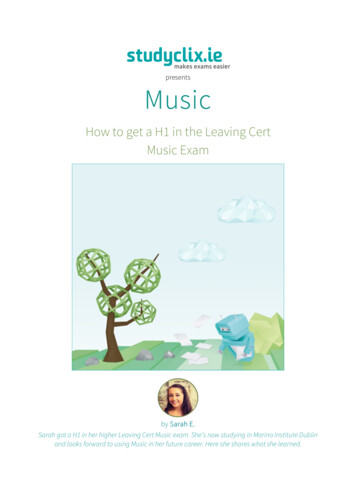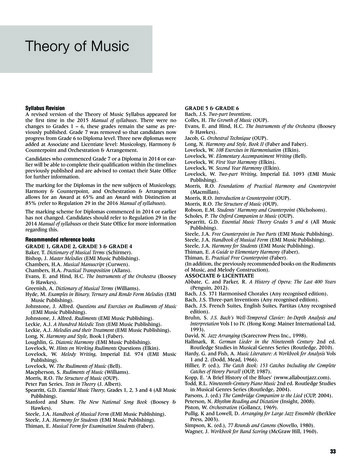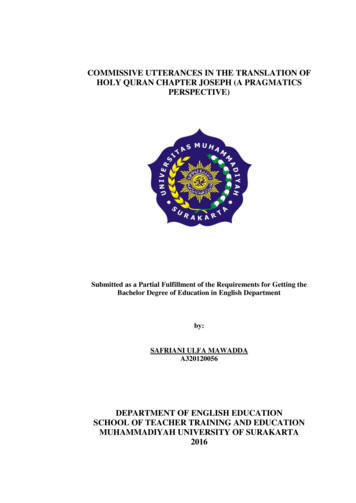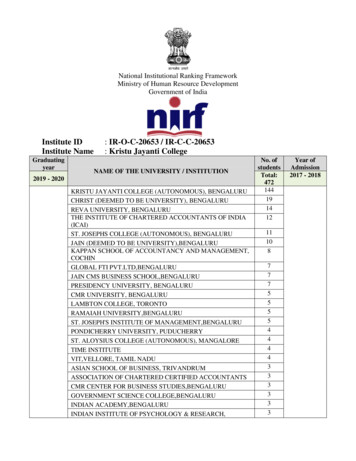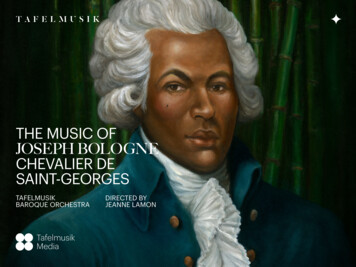
Transcription
THE MUSIC OFJOSEPH BOLOGNECHEVALIER DESAINT-GEORGESTAFELMUSIKBAROQUE ORCHESTRATafelmusikMediaDIRECTED BYJEANNE LAMON
THE MUSIC OFJOSEPH BOLOGNECHEVALIER DESAINT-GEORGESJoseph Bologne,Chevalier de Saint-Georges(1745–1799) EXCERPTS FROM L’AMANTANONYME (1780):1–3Tafelmusik Baroque Orchestra uverture (also pub. as SymphonyOin D Major, op. 11, no. 2)1Allegro Ballet no. 12:136Ballet no. 61:38VIOLIN CONCERTO IN D MAJOR,OP. 3, NO. 1 (1774)7Allegro maestoso8Adagio5:389Rondeau4:1610:56Linda Melsted, violin soloistSYMPHONY IN G MAJOROP. 11, NO. 1 (1779)DIRECTED BYJEANNE LAMON10Allegro4:4711Andante5:5912Allegro assai3:20
Violin I: Jeanne Lamon, Thomas Georgi, GenevièveGilardeau, Linda Melsted, Christopher VerretteJean-Marie Leclair(1697–1764)13 llegro, from Violin Concerto inAF Major, op. 10, no. 4 (1745)Violin II: Stephen Marvin, Emily Fowler,Rona Goldensher, Kevin Mallon7:21Geneviève Gilardeau, violin soloistViola:Elly Winer, Patrick G. Jordan, Ivars TaurinsVioloncello:Christina Mahler, Allen WhearBass:Alison MackayFlute:Elissa Poole, Alison MelvilleOboe:John Abberger, Marco CeraBassoon:Dominic TeresiHorn: Derek Conrod (Gossec), Ronald George (SaintGeorges), Scott WeversHarpsichord:Charlotte Nediger (Leclair)Recorded at Humbercrest United Church, Toronto, May 30–June 1, 2002.François-Joseph Gossec(1734–1829)Project Manager:Randy BarnardRecording Producer:Karen WilsonRecording Engineer:Doug DoctorAssistant RecordingEngineer & Mastering:Peter CookDigital Editing:Natasha Aziz SYMPHONY IN D MAJOR,OP. 5, NO. 3, “PASTORELLA” (c.1761– 2)14Adagio lento – Allegro4:1615Adagio3:5516Minuetto & Trio2:3517Allegro4:39A production of Tafelmusik Media 2021. Originally released by CBC 2003.Tafelmusik Media is a trademark of Tafelmusik.Design: Puncture DesignCover image: Opus 7 by Gordon Shadrach, 2021, gordonshadrach.comConsultant: Ranlin Consulting, Canada (Randall Barnard)Total timing: 72:51All rights reserved.Unauthorized use or duplication is a violation of applicable laws. and Tafelmusik MediaMade in Canadatafelmusik.orgTafelmusikMediaTMK1032CD
FOREWORDIN THESHADOWSOF MOZARTNO MOREJoseph Bologne, Chevalier de SaintGeorges: the 21st-century revival of the18th-century trailblazerUnlike Wolfgang Amadeus Mozart, Joseph Bologne, Chevalier de Saint-Georges,is not a household name, but in the 18th century he was one of the greatestmusicians of his day. At this time when Paris, the City of Light, was a culturalcapital of Europe, Saint-Georges was a celebrated guest in the many salons ofthe French aristocracy, including those of the Austrian-born queen of France,Marie Antoinette, who was herself an accomplished musician. He inspired fellowcomposers of the time — Franz Joseph Haydn, François-Joseph Gossec, CarlStamitz, and especially Wolfgang Amadeus Mozart — making him a leader ofhis century’s musical development rather than a follower of trends. He has beenunfortunately compared to the revered Austrian composer by the pejorativemisnomer “Le Mozart Noir” (The Black Mozart), when in fact the comparisoncould have been reversed.As a historical figure alone, Saint-Georges’ accomplishments were extraordinary.He was a celebrated colonel in the French military during the Revolution and oneof the greatest fencers of the time. U.S. president John Adams declared him “themost accomplished man in Europe.” His many escapades are surmised to haveinspired the classic novel Les Trois Mousquetaires (The Three Musketeers) byAlexandre Dumas, whose father Thomas served under Saint-Georges inthe Légion franche de cavalerie des Américains et du Midi, notably called theLégion Saint-Georges.During the Age of Enlightenment, France was home to many great artistsand thinkers. Luminaries of this era included Voltaire and Jean-Jacques Rousseau.Among the most prominent musicians was none other than Joseph Bologne,Chevalier de Saint-Georges. A remarkable violinist, orchestra leader, andcomposer, he was at the centre of Parisian musical life in the late 1700s. He wasa trailblazer who commissioned and led performances of great works, such asthe six Paris Symphonies of Haydn (nos. 82–87).BY MARLON DANIELOne can see traces of Saint-Georges and the French style in Mozart’s quartetsand violin concertos following the Austrian composer’s visit to Paris in 1778.Mozart was introduced to the symphonie concertante, a multi-instrumentconcerto-symphony hybrid that was very popular in Paris, and a genre of whichSaint-Georges was undisputed master. He composed 10 of these that we knowabout. Saint-Georges’ Symphonie concertante in G Major op. 13, no. 2, impressedMozart, who wrote his Symphonie concertante in E-flat for violin and viola, K. 394,a year later. In this most memorable of Mozart’s works, one can find similarities in
FOREWORDform and structure, and certain idiomatic passages are emulated. In the thirdmovement, the soloists’ climactic and virtuosic final rising passage is almostidentical to the final passage in the first movement of Saint-Georges’ work.This is a good example of how Saint-Georges’ innovative musical style andapproach pushed the boundaries of violin technique, expanding the use of theuppermost register and foreshadowing the work of romantic-period violinistcomposers such as Niccolò Paganini and Pablo de Sarasate. By shining a lighton these contributions, we can challenge the Austro-Hungarian Empire’s holdon defining the classical style as it is known today.We are now gradually recognizing Saint-Georges’ influence and impact on 18thcentury music, although many of his works — including his operas and clarinetconcerto — were lost during the French Revolution and especially during itsReign of Terror. Later, his blackness and the dominance of white supremacyin classical music became an insurmountable barrier to the recognition of hiscontributions. He and other composers of colour were relegated to “minor”composer status over subsequent centuries.ABOUT MARLON DANIELMarlon Daniel is a noted conductor, pianist, and educator.He is the foremost exponent on the life and music of JosephBologne, Chevalier de Saint-Georges, and a champion of worksby composers of African descent. He is the Artistic and MusicDirector of the Festival International de Musique Saint-Georgesand has given numerous lectures on the composer in Europe,North America, and the Caribbean, as well as at institutions thatinclude Columbia and Yale Universities.It was only in the late 20th century that scholars and musicians beganto approach Joseph Bologne’s life and music with renewed interest. Newlydiscovered manuscripts and the restoration of both previously published andunpublished works have led to a resurgence in the scholarship and popularityof the composer. He is now rightfully regarded as one of the foremost virtuosoviolinists of his day, as well as an innovative and influential composer.Notably, Tafelmusik, under the direction of former music director JeanneLamon, took part in one of the earliest efforts to recognize Joseph Bologne,Chevalier de Saint-Georges’ vast contributions to classical music. In 2003,the first and only documentary film on the composer to date was released,a collaboration between Media Headquarters, the Canadian BroadcastingCorporation (CBC), and Tafelmusik. This groundbreaking documentary and itsassociated audio recording sparked a further wave of interest in the composer,engaging many new audiences with his life and works. They also helpeddebunk the myth that composers of colour were non-existent in the realm ofclassical music before the 20th century.
JOSEPHBOLOGNECHEVALIERDE SAINTGEORGES“Joseph Bologne, Chevalier de SaintGeorges, was widely regarded as the mostaccomplished man of his age. Not only washe among the most important musicians inParis during the pre-revolutionary period,but he was also a superb all-round athleteand man of arms.Among connoisseurs of the art of fencing,Saint-Georges was considered the finestswordsman in Europe, possessed ofextraordinary speed, flexibility and grace,qualities which he also exhibited inabundance as a violinist. The combinationof artist, athlete and man of action — for healso held military commands during therevolutionary period — is unique in the historyof music and the man himself scarcely lessextraordinary than the phenomenal rangeof his talents.”—ALLAN BADLEY, SAINT-GEORGES BIOGRAPHY, ARTARIA.COMBY CHARLOTTE NEDIGER
JOSEPH BOLOGNE,CHEVALIER DE SAINT-GEORGESDetails of the birth of Joseph Bologne Saint-Georges are sketchy, but itis likely that he was born in 1745. His father, George de Bologne, a formerGentleman of the King’s Bedchamber, was a wealthy plantation owner inthe commune of Baillif in the Basse-Terre region of Guadeloupe. His mother,Nanon, was one of the enslaved people on the plantation and believedto be of Senegalese descent. In 1753, the Bologne family left for France,settling in Paris. The domestic situation of George Bologne de Saint-Georgeswas unconventional: accompanying him to France was his legal wifeElizabeth, his mistress Nanon, and his illegitimate son Joseph; a legitimatedaughter was already in Paris. Later, Joseph was given the family name,and George went out of his way to ensure that his son received the bestpossible education.George’s interest in his son’s education was undoubtedly encouraged byJoseph’s extraordinary natural abilities. He spent six years at Nicolas Texierde la Boëssière’s Académie royale polytechnique des armes et de l’équitation(fencing and horsemanship), receiving a strong academic and physicaleducation. Joseph’s teachers were astounded by his facility for learning: inaddition to his prodigious talent as a fencer, the young Joseph excelled inriding, skating, swimming, running, target shooting, and dancing. He becamea member of the Gendarmes de la garde du roi and seemed destined for amilitary career.Although his musical talents were obviously as noteworthy as his many othergifts, no account of his musical education has survived. His father was a notablepatron of music and received dedications from a number of composers,among them the violinists Antonio Lolli and Carl Stamitz, who might have beenamong Joseph’s teachers. The dedication of Stamitz’s Orchestral Quartets op. 1thanks George Bologne for “his invaluable gift in the person of his son.”Other teachers might have included the violinist Jean-Marie Leclair and thecomposer François-Joseph Gossec.The master swordsman Henry Angelo wrote that “Saint-Georges combinedin his person his mother’s grace and good looks and his father’s vigour andassurance.” Tall, handsome, and gifted, Joseph was a fashionable and welcomeguest in many salons, where his musical talent and magnetic charisma shone.“Saint-Georges’success as a violinist,director, and composer ofinstrumental music wasunquestioned.”In 1769, concert life in Paris was remarkably rich. There were regular concertsin the homes of the musically inclined members of the aristocracy, in additionto several successful concert series, notably the highly successful Concertspirituel, and Gossec’s newly established Concert des amateurs, where SaintGeorges undertook his first professional engagement as an orchestral violinist.Both of these organizations boasted large and highly skilled orchestras, andGossec’s series in particular featured newly composed music. Saint-Georgesmade his solo debut with the Concert des amateurs in 1772, performing histwo Violin Concertos op. 2. When Gossec left a year later to take over directionof the Concert spirituel, he handed over the direction of the Concert desamateurs to Saint-Georges. It was among the finest orchestras in Europe, withsome 75 players, and it thrived under Saint-Georges’ direction until he disbandedit in 1781. He immediately replaced it with the Concert de la loge olympique,founded under the auspices of the Société olympique, a masonic lodge. It wasessentially a reincarnation of his former orchestra, sponsored by the comted’Ogny and with the support of the duc d’Orléans. Its reputation continued toincrease, and the orchestra moved from its premises at the duke’s Palais Royalto the prestigious Salle des gardes in the Tuileries. It was for this orchestrathat the comte d’Ogny commissioned Haydn’s Paris Symphonies, withSaint-Georges as intermediary. Saint-Georges directed their triumphantpremieres in 1787.
JOSEPH BOLOGNE,CHEVALIER DE SAINT-GEORGESSaint-Georges’ success as a violinist, director, and composer of instrumentalmusic was unquestioned. This led to the publication of numerous violin concertos,symphonies concertantes, quartets, and sonatas. From the mid-1770s, SaintGeorges devoted increasing time to the composition of opera, despite an earlyrejection at the Académie royale de musique (known today as the Paris Opera).He had been proposed as music director of the Académie in 1775, but hisnomination was withdrawn after the submission of a petition to Queen MarieAntoinette signed by three of the leading ladies of the company, stating that“their honour and the delicate nature of their conscience made it impossiblefor them to be subjected to the orders of a mulatto” (as recounted by Baronvon Grimm in his Correspondance littéraire, philosophique et critique). This overtdiscrimination may well have discouraged Saint-Georges, but it did not dampenhis enthusiasm for opera, and he devoted considerable energy between1777 and 1790 to composing and producing seven comic operas, with variedsuccess. The only complete opera score to survive is L’amant anonyme,produced in 1780.The last decade of Saint-Georges’ life was dominated by the French Revolution,his musical career all but abandoned. He had continued throughout the yearsto use his prowess as a swordsman and athlete to replenish his oft-ailing fortunes.In England, he was probably better known as a fencer than as a musician andsuccessfully mounted exhibition matches: his only extant portrait, with swordin hand and violin relegated to the background, was done in England and copiessold by the thousands. When, in 1789, the Revolution proclaimed the equality ofall men, Saint-Georges was among the first to join the National Guard. A fewyears later, he was named colonel of the Légion franche de cavalerie desAméricans et du Midi, a thousnd-strong troop of Black soldiers commonlyreferred to as the Légion Saint-Georges. It attracted volunteers from all over thecountry, including Thomas Alexandre Dumas, the father of author AlexandreDumas. Dumas the younger would presumably have learned about the fencingprowess of Le Chevalier from his father, and it is likely that Saint-Georges wasthe inspiration for the character d’Artagnan in Les Trois Mousquetaires(The Three Musketeers).During the Reign of Terror (1793–1794), Saint-Georges spent 18 monthsin prison. His close friend and fellow activist Philippe Égalité, the young ducd’Orléans, met his end at the guillotine. An attempt by Saint-Georges torejoin the army was unsuccessful. The end of his life was rather scatteredand included a visit in 1795 to Saint-Domingue, where he witnessed a bittercivil war between Revolutionary forces and those wishing to restore slavery.Disillusioned, in 1797 he returned to France and to music, founding a neworchestra, the Cercle de l’harmonie, at the former residence of the Orléansfamily. Saint-Georges died of a bladder infection in 1799 at the age of 53. Hewas legendary in his time, as attested by the U.S. president John Adams, whoreferred to him as “the most accomplished man in Europe.”This recording includes a selection of the orchestral works of the Chevalier deSaint-Georges, as well as the works of two of his mentors, Leclair and Gossec.Both of Saint-Georges’ two extant symphonies are included; he used thesecond of these as the overture to his opera L’amant anonyme, and we haveappended a few dances from the opera. Saint-Georges’ strongest compositionsare those in which his bow guided the pen. In the Violin Concerto in D Major,op. 3, no. 1, one has the sense that it is Saint-Georges’ remarkable skill as aplayer that inspires the work, from the virtuosity of the first movement, to thelyricism of the second movement, to the playfulness of the final Rondeau.Whether Saint-Georges undertook formal study with Jean-Marie Leclair isnot known, but Leclair’s influence on French violinists continued to be strongto the end of the 18th century. He was renowned for both the brilliance of histechnique and the sweetness of his tone.The prolific composer and conductor François-Joseph Gossec outlived hisprotégé Joseph Bologne by 30 years. His encouragement and public supportof the young Saint-Georges was pivotal in ensuring the latter’s successfulentrance into Parisian musical society. Gossec was a remarkable entrepreneur,and eventually became the musical spokesman of the Revolutionary movement,and his influence on Saint-Georges in these arenas undoubtedly continuedlong after their musical partnership ended.
Cover ArtworkOpus 7, oilGordon Shadrach, 2021About TafelmusikGordon Shadrach has had a lifelong fascination with the semiotics of clothingand its impact on culture. In particular, his interest lies in the intersection andcodification of race and fashion. These codes impact the way we navigatethrough spaces and influence how people associate with one another.Shadrach’s portraits of Black men utilize fashion — contemporary or historicaldress — to create narratives that pull viewers in to explore the biases embeddedin North American culture. Shadrach seeks to disrupt the colonial constrictionsof portraiture by inviting viewers to reflect upon the depiction of Black people inart and culture. Shadrach is a graduate of OCAD.Led by Music Director Elisa Citterio and Executive Director Carol Kehoe,Tafelmusik is an orchestra, choir, and experience that celebrates beautythrough music of the past.Founded over 40 years ago on the pillars of passion, learning, and artisticexcellence, Tafelmusik continues to bring new energy to baroque musicand beyond. Historically informed performances of 17th- to 19th-centuryinstrumental and choral music (led by Chamber Choir Director Ivars Taurins)share the stage with vibrant, insightful multimedia programs, and bold newmusic written just for the group. Each piece is played on period instruments,underscored and illuminated by scholarship.Through dynamic performances, international touring, award-winningrecordings, and comprehensive education programs, Tafelmusik invitesaudiences to engage with beauty and experience the breadth ofemotion music can inspire.tafelmusik.org
debunk the myth that composers of colour were non-existent in the realm of classical music before the 20th century. Marlon Daniel is a noted conductor, pianist, and educator. He is the foremost exponent on the life and music of Joseph Bologne, Chevalier de Saint-Georges, and a champion of works by composers of African descent.






